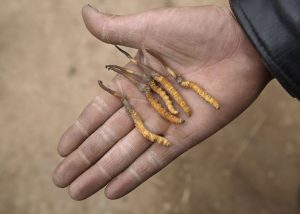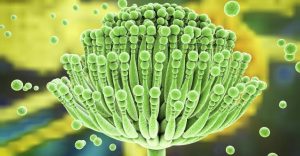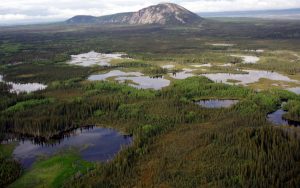Humans have a long history with fungi that spans fear, curiosity and dependence. In the U.S, the word fungus often conjures images of that scary green mold that eats your food before you can, or unfortunate infections of the feet. The age old fear of mushrooms, the fruit of some fungi, persists around the globe. Many believe the myth that simply touching a toxic mushrooms will cause harm, when they must be ingested to do any damage.

Illustration of toxic fungi by Val Starnes, c.1900 (Image courtesy of Farlow Library, Archives, and Herbarium of Cryptogamic Botany)
Nonetheless, mushrooms and fungi have also held abundant cultural and ecological value since they first arose from the Earth’s primordial soup. Their uses by humans include but are not limited to:
- Food (wild and cultivated macrofungi)
- Medicine (mind, body, and spirit)
- Filtering environmental waste (Mycoremediation)
- Tinder (holding and transporting fire)
- Fibers for clothing and building
- Dyeing fibers
- Fermentation and aging of food and drinks by microscopic yeasts
Ötzi the iceman, a 5,000 year old mummified body found preserved in the Alps, was found with two types of polypore mushrooms strung through leather. It’s suspected the tinder fungus (Fomes fomentarius) was used as a fire lighting kit and Birch Polypore (Fomitopsis betulina) as a first aid kit as it is antimicrobial and a helps stops bleeding. (Peintner, et al., 1998)
Climate Change and Fungi
The historical and modern uses of Fungi are vast, but what’s in store for the future? A warming global climate suggests there will be serious impacts on the range and function of fungal species. Where Fungi weren’t noticed before, they soon might be. Alternatively, where Fungi have cultural and economic significance, the threat of their loss poses serious concern.
Tibet
The Caterpillar fungus (Ophiocordyceps sinensis) or yartsa gunbu as it is known in Tibet is entomopathogenic, meaning it feeds on insects. The fruits of this fungus are harvested annually in the Himalayas and are a highly valued resource in the region. The caterpillar fungus is used in traditional Tibetan and Chinese medicine, often prescribed for lung, kidney, and liver issues.
he price for yartsa gunbu has skyrocketed since the early 2000s, which shapes the social-economic aspect of rural people in the Tibetan plateau. By collecting yartsa gunbu, local people earn more than ten times the annual average income.”
A 2017 Biological Conservation research effort investigated reports of decline of the fungus in the region where the fungus is endemic. The study concluded that “the distribution range of the fungus wound decrease significantly, shifting upward in altitude and toward the central part of the Plateau.” (Yan, et al., 2017)
Warmer temperatures that are less hospitable for the fungus cause it took seek habitat at higher elevations that fit its optimal range. Montane species of all kingdoms are the first at risk in the face of climate change.
Friend or foe?
While this article has highlighted the reliance of humans on fungi, we must remember that the fear of fungus is also rooted in valid concerns. While we’re lucky to have achieved the levels of symbiosis with our fungal allies, this kingdom of life holds many of our enemies as well.
Europe
Italy, France, and Spain are the world’s leading producers of an iconic beverage with ancient history, wine. The winemaking process depends on the presence of yeast, a microscopic fungus, that transforms grape juice into the coveted beverage. The European Union Wine Market Data Portal reported that between 2013 and 2017, the EU’s average annual production was 168 million hectolitres. “European wine-making employs around 1.5 million people, and annually generates about $22 billion.”
But there’s another fungus involved in the winemaking process, and it’s a dreaded invader. Toxins known as Mycotoxins are produced by Fungi like Aspergillus (one of the molds that eats your food) that contaminate whatever they grown on. Grapes in wine production are susceptible to infection, the most concerning mycotoxins are Ochratoxins.
A 2018 study of predominant mycotoxins in wine and climate change related to wine states that “climate is the most important factor in determining contamination once the fungi are established, with high temperatures being a major factor for Ochratoxin contamination” (Patterson, et al., 2018)
Canada
The Boreal forest, or Taiga, is the world’s largest land biome. This biome has a subarctic climate with a very large temperature range between seasons spans, most notably long and cold winters. The Taiga spans most of inland Russia and Canada, as well as most of Sweden, Finland, Norway and some of the Scottish Highlands.
Here we find peatlands, ecosystems that accumulate partially decayed vegetation or organic matter over thousands of years. The peatland ecosystem is the most efficient carbon sink on the planet, storing as much as 500 billion metric tons of carbon. That’s twice as much Carbon as all the trees in the world’s forests can process!
As decomposers, fungi play a vital role in these peatland ecosystems and the carbon sequestration that occurs within them. A 2018 study in Ontario warns that shifts in fungal composition due to warming temperatures may reduce long-term C storage of boreal peatlands under future climate change scenarios. (Asemaninejad, et al., 2018)
Destruction of peatlands also poses threats to these valuable ecosystems. As peat is removed to use as a fuel source, lost moisture inhibits the natural processes that allow carbon to be stored.
Hope for the future
It’s clear that humans have an intimate relationship with fungi. Awareness of these relationships around the world has increased as the global climate has began shifting. While much of this news may be disheartening, there is still positive work being done to help maintain fungi’s role in the environment and therefore their role in the lives of many humans.
Protection of ecosystems that sustain fungi is constantly in the works. In areas where bogs have begun to drain, special dams have been put in place to keep them wet and prevent degradation.
Restoration of ectomycorrhizal forests (see first blog post) is underway around the world. These efforts allow more Carbon to be pulled from the atmosphere, as well as providing habitat to countless organisms.
Mycoremediation (see second blog post) projects are using fungi to help filter out toxic pollutants in the environment, helping heal communities of plants, fungi, animals, and humans alike.
A Seattle based research group, Symbiogenics, is conducting ground breaking research involving fungi, agriculture and much more. They share this mission statement:
“motivated by global declines in agricultural and natural habitats, and increased frequencies of famine and human disease, the founders sought to develop solutions for a sustainable future based on one of the most fundamental aspects of all plant and animal life on earth – symbiosis.”
Their focus on the symbiotic relationships between fungi and other organisms is giving way to hopeful human adaptations to climate change. Watch the video below to learn more about their work.
References:
Peintner, U., Pümpel, T., & Pöder, R. (1998). The Iceman’s fungi. Mycological Research. Retrieved from https://www.researchgate.net/publication/222280519_The_Iceman’s_fungi.
Yan, Y., Li, Y., Wang, W., He, J., Yang, R., Wu, H., . . . Yao, Y. (2017). Range shifts in response to climate change of Ophiocordyceps sinensis, a fungus endemic to the Tibetan Plateau. Biological Conservation, 206, 143-150. doi:10.1016/j.biocon.2016.12.02
Caterpillar fungus. (n.d.). Retrieved from http://biodiversitymeanslife.ch/caterpillar-fungus
Patterson, R. M., Venâncioa, A., Nelson, L., Guilloux, M., & Rousseaux, S. (2018). Predominant mycotoxins, mycotoxigenic fungi and climate change related to wine [Abstract]. Food Research International. Retrieved from https://www-sciencedirect-com.evergreen.idm.oclc.org/science/article/pii/S0963996917306622.
Asemaninejad, A., Thorn, R., Branfireun, B., & Lindo, Z. (2018). Climate change favours specific fungal communities in boreal peatlands. Soil Biology and Biochemistry. Retrieved from https://www-sciencedirect-com.evergreen.idm.oclc.org/science/article/pii/S0038071718300282.
Biello, D. (2009, December 08). Peat and Repeat: Can Major Carbon Sinks Be Restored by Rewetting the World’s Drained Bogs? Retrieved from https://www.scientificamerican.com/article/peat-and-repeat-rewetting-carbon-sinks/
Black, R. (2007, March 28). Science/Nature | ‘Preserve peat bogs’ for climate. Retrieved from http://news.bbc.co.uk/2/hi/science/nature/6502239.stm
Home. (n.d.). Retrieved from http://www.symbiogenics.org/




Leave a Reply